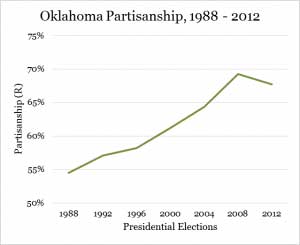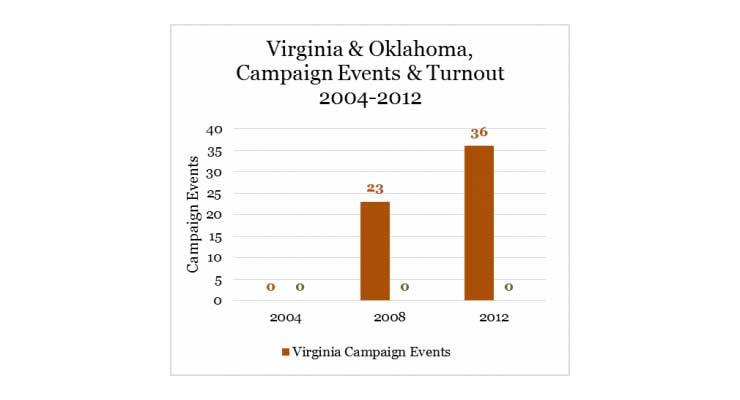Lawmakers had pushed Oklahoma electoral college law changes earlier but new concerns have blocked its passage. The following article, “Oklahoma Voter Turnout Suffers without National Popular Vote Plan” was posted recently at FairVote by Claire Daviss and Rob Richie:
An Oklahoma bill to sign onto the National Popular Vote Interstate Compact (NPVIC) has been postponed until next year. Without states like Oklahoma joining the compact, Oklahoma voters will be a disadvantage during and between presidential elections.
 The core problem is one shared by some two-thirds of states. Oklahoma is a safe red state, as it has been for decades. In 2012, Romney won 67% of Oklahoma presidential votes compared to 47% nationwide, which translates into an underlying presidential partisanship with a strong Republicans advantage. Oklahoma has become steadily more Republican almost every election over the past 25 years.
The core problem is one shared by some two-thirds of states. Oklahoma is a safe red state, as it has been for decades. In 2012, Romney won 67% of Oklahoma presidential votes compared to 47% nationwide, which translates into an underlying presidential partisanship with a strong Republicans advantage. Oklahoma has become steadily more Republican almost every election over the past 25 years.
The safeness of Oklahoma for Republican presidential candidates has serious effects on the attention Oklahoma voters receive during and after presidential elections. During the 2012 presidential race, candidates spent only $1,300 on ads in the state (compared to the millions spent in swing states) and did not hold a single general-election campaign event in Oklahoma (compared to 73 campaign events in Ohio, 40 in Florida, and 36 in Virginia).
Furthermore, new evidence from the Brookings Institution suggests that safe states like Oklahoma continue to be under-served between presidential elections. Between 2011 and 2013, safe red states received less federal discretionary spending. Safe red states received, on average, “nearly 15 percent fewer grants and 1.3 percent fewer grant dollars than the average swing state.”
Candidates, and eventually presidents, have little incentive to pay attention to Oklahoma. On the flip side, Oklahoma voters have little incentive to pay attention to campaigns, knowing that their state’s electoral votes are already all-but-guaranteed to the Republican candidate. The result is that Oklahoma’s voter turnout in presidential elections is lower than the nationwide average — and declining.
Inaccurate Analysis From OCPA’s Trent England
The Oklahoma Council of Public Affairs’ Trent England recently blogged about how some states have high voter turnout without being presidential battlegrounds. But he misinterprets the data — and in so doing invites a discussion that shows just how problematic the current system is for campaign attention and voter turnout.
England bases his claim on a Christian Science Monitor article from November 2012. This article does not, as England claims, profile “the six states with the highest turnout in 2012.” Instead, the article averages voter turnouts over the past six federal election cycles, both presidential and mid-term.
Because the data includes mid-term elections and presidential election turnout over time, the Monitor analysis obscures the effect of presidential battleground status on voter turnout in 2012. A more specific analysis—one that considers actual turnout and centers on turnout at presidential elections—is obviously needed.
Battleground Status and Voter Turnout in Oklahoma: FairVote’s Analysis
The six states with the actual (not projected) highest voter turnout in the 2012 presidential election are listed below.
Top 6 States, Voter Turnout (VEP), Presidential Election, 2012
1. Minnesota – 76.1%
2. Wisconsin – 72.9%
3. Iowa – 70.3%
4. New Hampshire – 70.2%
5. Colorado – 69.9%
6. Maine – 68.2%
…
49. Oklahoma – 46.3%
The five states with the highest voter turnout in 2012 were all swing or near-swing states, all with partisanship indexes within 2% of a 50-50 even partisan split. Maine, the state with the 6th highest turnout, has a partisanship of 44.2%, making it a Democratic leaning state that has shifted away from battleground status over time. Oklahoma falls to the near end of the list in voter turnout and has a partisanship of 67.7% Republican. Suffice it to say, the actual 2012 numbers suggest that swing state status may indeed have an effect on voter turnout.
The data from 2012 is consistent with the general trend among battleground states and safe “spectator states.” FairVote found that in 2012, the 42 spectator states had a collective voter turnout of 56.9%, nine percentage points lower than the collective voter turnout among battleground states, 65.7%.¹
Additionally, battleground states experience increases in the number of voters participating in elections far more often than spectator states. As FairVote wrote in its contribution to the Presidential Studies Quarterly:
[In 2012] eight of the nine battleground states had an increase in their number of voters from 2008. In the remaining 42 states (including Washington, DC), only 11 states had an increase in their number of voters. Instructively, two of the largest turnout declines (more than four percentage points each) were in Michigan and Pennsylvania, 2008 battlegrounds that in 2012 were relatively ignored.
Voter Turnout Trends in Oklahoma and Virginia: Charts Tells Dramatic Story
When a state becomes a battleground state, its voter turnout increases. This is evident in contrasting Oklahoma and Virginia. In 1992, Oklahoma had higher voter turnout than Oklahoma and stayed relatively close together until 2008. Virginia had been a safe red state for years, but as its partisanship grew closer to 50%, candidates began to take note. In 2008 and again in 2012, candidates greatly increased the number of events, campaign spending and get-out-the-vote operations in Virginia — but continued to ignore Oklahoma.

Virginia’s voter turnout, which had been below the national voter turnout for more than a decade, rose above the national voter turnout in 2008, while Oklahoma’s voter turnout plunged even lower. These trends are shown in these two telling charts.

Clearly battleground status and voter turnout are linked. Swing states receive more campaign attention, becoming battlegrounds. Campaign attention engages these states’ voters, so they turn out to vote in greater numbers. Meanwhile, voters in safe seats rarely hear from candidates and are less engaged in the race and less likely to turn out.
What that Means for National Popular Vote
If a national popular vote were used to elect the president, every voter in every state would matter equally. Swing states would not have outsized influence in federal discretionary spending. Voters in all states would have the opportunity to affect the outcome of presidential elections. Voter turnout would increase, just as it did in Virginia. Who stands to gain the most? Safe states, including safe red Oklahoma.
Oklahoma legislators will take up the National Popular Vote bill again, as will many more states that suffer under current Electoral College rules. We may not see a new system in place by 2016, but expect that 2020 will be the first election in which every in every state will have the same power to hold the president accountable.
Claire Daviss (@ClaireDaviss_FV) is a Research Fellow at FairVote. Rob Richie (@Rob_Richie) is the Executive Director at FairVote. To learn more about the National Popular Vote Interstate Compact, click here.
¹ Robert Richie and Andrea Levien, “How the 2012 Presidential Election has Strengthened the Movement for the National Popular Vote Plan,” Presidential Studies Quarterly 43, no. 2 (June), pp. 353-376 (pp. 1-22 in PDF). See page 13 in PDF.
Leave a Reply